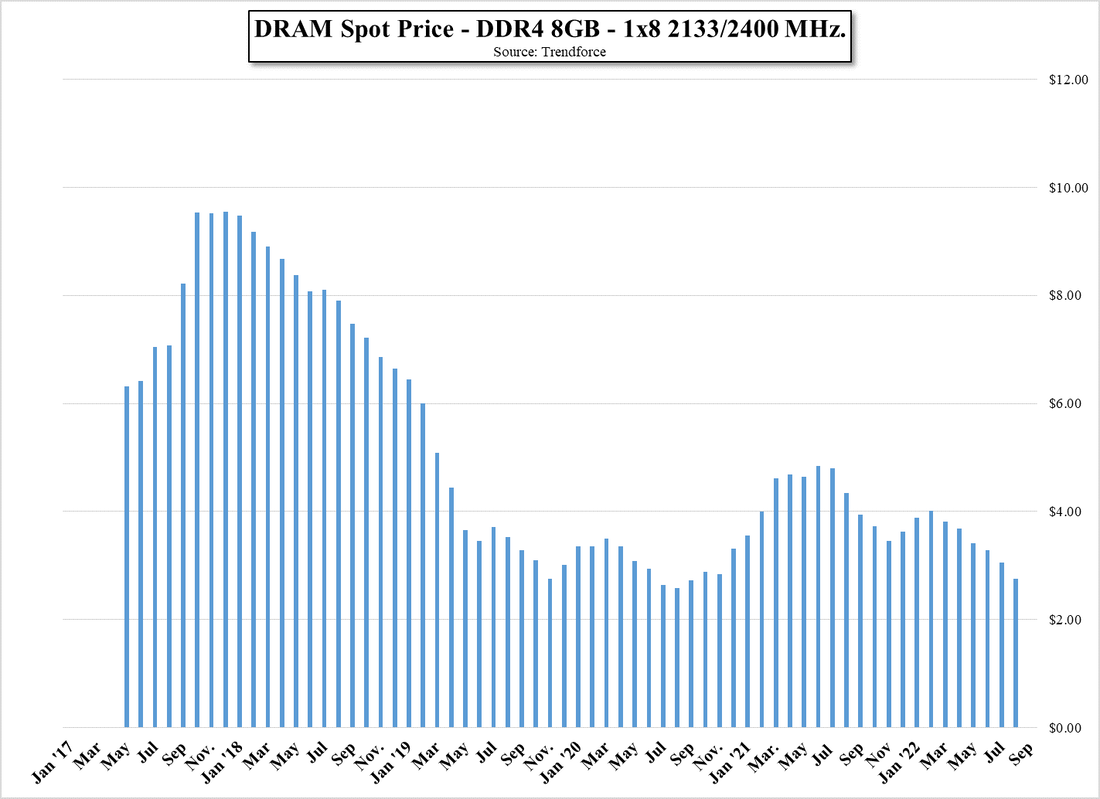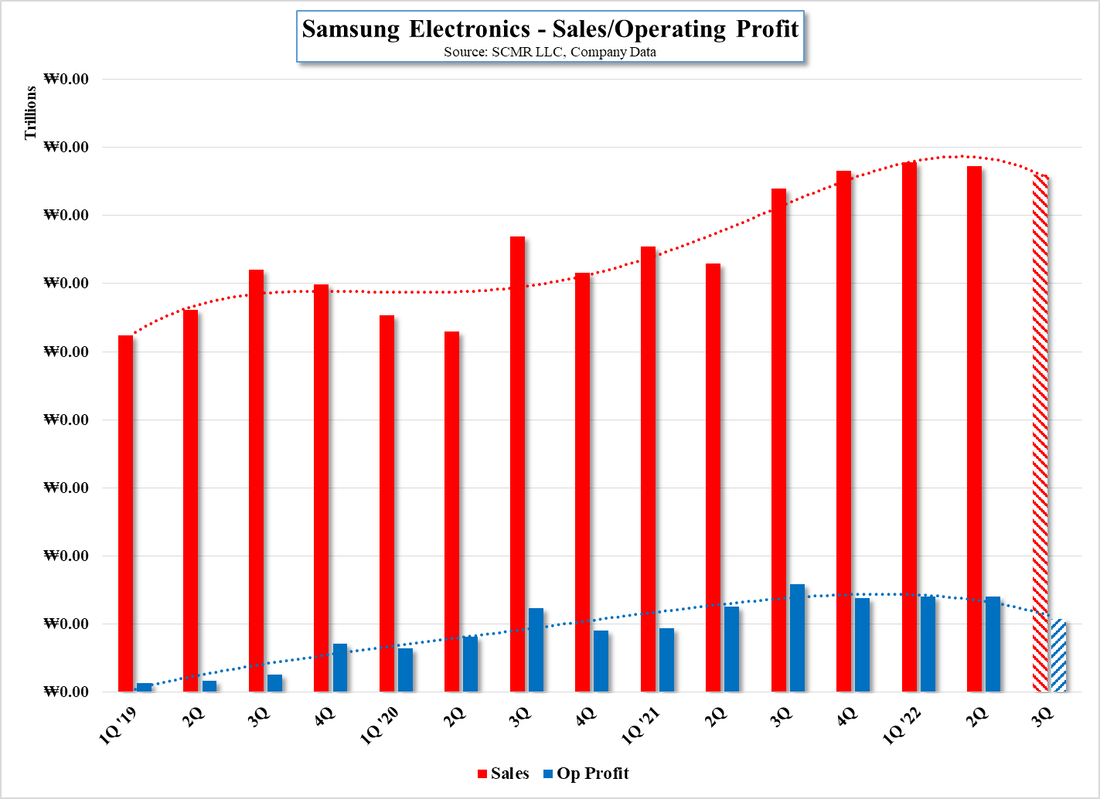Samsung TV – 2022 & 2023
We note that predictions for the TV space in 2023 are just beginning to be forecasted and a few targets are being bandied about, but after the tumultuous year the CE space faced in 2022, we and others seem a bit more cautious about making predictions this early in the year. Excluding our own forecasts, which we have yet to make, the general tone for the TV set industry is looking flat to down slightly, and has the potential to fall below 200m units for the first time since 2017, but TV set brands are a confident lot, especially this early in the year, and are making plans to build up their consumer TV offerings as they do each year.
Samsung Electronics does have some problems in the TV set space, particularly when it comes to OLED TV, where fellow South Korean competitor LG Electronics (066570.KS) and its display LG Display (LPL) dominate the OLED TV space. As Samsung Display (pvt) decided many years ago (2013 to be exact) that it was not economically feasible to produce OLED TVs using the same production methodology it used to produce OLED smartphone displays, it abandon the production of OLED TVs, eventually backing the use of quantum dots to enhance the company’s existing LCD TV technology. Samsung Electronics championed QDs and adopted it across a wide swath of its LCD TV line over the years and has since added Mini-LED backlighting to its higher end models, but lacked a TV set that could compete directly with LG’s OLED TV set line, which has been gaining traction as LGD slowly added capacity.
This changed in 2020 when Samsung Display began developing production capabilities for an OLED TV of its own, but not using the same technology as used by LG. LG Display’s OLED technology, known as WOLED, is based on a layer of yellow/green phosphorescent emitter material combined with a blue fluorescent emitter material. These materials are coated on a TFT (Thin-film Transistor) backplane and covered with a color filter, essentially a sheet of red, green, and blue phosphor dots. The white light created by the emitting material passes through the color filter, with each red, green, blue or ‘blank’ phosphor dot filtering out the remaining colors to produce red, green, blue, and white dots for each TV pixel, which each being controlled by the TFT structure below the emitting material. One big drawback of this process is that using a color filter is a subtractive process, as, for example, the red phosphor in the color filter blocks the blue and green light that make up white light, which means the brightness of each pixel is severely reduced. LG compensates by adding a transparent dot as part of each pixel, letting the unchanged white light through and adding to the pixel’s brightness, but while this helps the set’s overall brightness, it reduces the overall color intensity.
Samsung Display found that using a similar emitting structure, blue fluorescent and green phosphorescent emitters coated on a similar TFT backplane, instead of using a color filter, they could use quantum dots to convert what is blueish/green light to red, green and blue sub-pixels without much of the brightness and color loss. Quantum dots, rather than filtering out colors, ‘shift’ the frequency of the light, so the red quantum dot took the blue/green light and shifted it to red, while the green and blue quantum dots shifted the light to those primary colors, with no need for a white sub-pixel. The result is a TV with a more vibrant color palette, with the potential for a brighter set.
There has been a problem however, which is that LG Display has been producing WOLED TV displays for 10 years, while Samsung Display is still in what would be called relatively small scale production and that is a problem for Samsung Electronics, who needs more QD/OLED volume than SDC can produce if it is to have a significant place in the Samsung TV lineup. Given that 2022 was really the first year of production for SDC’s QD/OLED display line, decisions as to building out new capacity needed to be based on consumer acceptance of the product, and while said displays and TVs received positive reviews, it was a terrible year for the TV set business and capacity increases were low priority. Parent Samsung Electronics even went as far to bargain with rival LG Display over the purchase of millions of WOLED TV panels to fill out the 2022/2023 Samsung TV line, but negotiations did not resolve outstanding price issues and no agreement was made in 2022.
As Samsung Electronics begins to reveal its TV set plans for 2023, they have indicated that they will be expanding their QD/OLED TV set offerings by adding a 77” model to the existing 55” and 65” models[1] that were offered in 2022. This was an inevitability, as premium size (>65”) TV sets continue to gain in popularity and tend to carry a higher premium than smaller sets, but indicates two things. First, a bit more confidence in the technology by Samsung Electronics, who, at times, seemed less than enthusiastic about QD/OLED, and second, that Samsung Display has brought its yields up enough to be able to allocate some production time to 77” panels, which will likely have lower yields, and can still meet 55” and 65” QD/OLED goals, both of which are important to the decision to increase QD/OLED capacity in 2023.
In the first table below we show Samsung’s 2022 and potential 2023 TV line-up based on size. 77” models are expected to be added to the QD/OLED line and potentially the Micro-LED TV line, while there is some speculation that Samsung will add a number of ultra-large sizes to the Micro-LED line, although we expect there is currently little need for those sizes given their very high cost and the marginal sales of the ultra-large Micro-LED line overall. One point that should be noted is that Samsung is now moving from Micro-LED TV modules based on PCB boards to TFT and Micro-LED placement on glass substrates.
This new modality is considerably closer to the more typical TFT processes used in OLED and LCD TVs, and can reduce the cost of smaller sets, eventually putting them in a range more amenable to consumers. We note also that Samsung has been reducing the size of each Micro-LED structure, enabling the higher resolutions needed for smaller consumer sets. The 146” set that was shown in 2020 had a chip that was 125um x 225um which was reduced to 75um x 125um in 2021 for the 110” demo. The 89” model is expected to have a chip size of 34um x 85um, which is a 69% area reduction in pixel size, although we note as Micro-LEDs get smaller it becomes more difficult to move them from die to substrate, so there is a trade-off as pixel size is reduced.
While the 2023 Samsung TV line does not have any major technology changes, at least at this pre-show point, it does show some progress on Samsung’s push toward Micro-LED, which remains a few years off for consumer TV products, and sets a decision point for QD/OLED. QD/OLED capacity as it stands, is too small to be a true TV set price tier placeholder, so a decision as to whether to add capacity must be made soon. Samsung continues to support quantum dot technology, which it has spread across almost all of its TV line, and can even be used as a simplified color conversion techniques for Micro-LED, but Samsung needs to compete with LG’s WOLED TV line, with the most likely candidate being QD/OLED, which would mean a more serious commitment to the technology at a time when capacity expansion projects are being postponed or eliminated. Samsung has made such commitments during difficult times in the past, but the alternative would be to buy OLED TV panels from LG Display which leaves little product differentiation. We expect Samsung to begin adding additional QD/OLED capacity before mid-year.
[1] SDC also produces a 34” QD/OLED display for monitors.


















 RSS Feed
RSS Feed